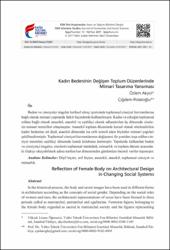Kadın Bedeninin Değişen Toplum Düzenlerinde Mimari Tasarıma Yansıması
Künye
AKYOL, Özlem, & Çiğdem POLATOĞLU. "Kadın Bedeninin Değişen Toplum Düzenlerinde Mimari Tasarıma Yansıması" FSM İlmî Araştırmalar İnsan ve Toplum Bilimleri Dergisi, 10 (2017): 1-24.Özet
Beden ve cinsiyetçi imgeler tarihsel süreç içerisinde toplumsal cinsiyet kavramlarına
bağlı olarak mimari yapılarda farklı biçimlerde kullanılmıştır. Kadın ve erkeğin toplumsal
rolüne bağlı olarak anaerkil, ataerkil ve eşitlikçi olarak adlandırılan üç dönemde cinslerin
mimari temsilleri oluşmuştur. Anaerkil toplum düzeninde kutsal olarak nitelendirilen
kadın bedenine ait dişil, ataerkil dönemde ise erili temsil eden biçimler mimari yapıları
şekillendirmiştir. Toplumsal cinsiyet kavramlarının değişmesi ile yeniden inşa edilen cinsiyet
tanımları eşitlikçi dönemde kendi üslubunu üretmiştir. Yapılarda kullanılan beden
ve cinsiyetçi imgeler, cinslerin toplumsal statüsünü, mimarlık ve toplum düzeni arasındaki
ilişkiyi okuyabilmek adına tarihin her döneminden günümüze önemli veriler taşımıştır. In the historical process, the body and sexist images have been used in different forms
in architecture according as the concepts of social gender. Depending on the social roles
of women and men, the architectural representations of sexes have been formed in three
periods called as matriarchal, patriarchal and egalitarian. Feminine figures belonging to
the female body regarded as sacred in matriarchal society and the figures representing masculine in patriarchal society have formed architectural structures. The definitions of
gender reconstructed with the alteration of the concepts for social gender have produced
their own style in the egalitarian period. The body and sexist images used in the structures
have transferred important data from each period of the history to perceive the social
status of sexes and the relation between architecture and social order.



















